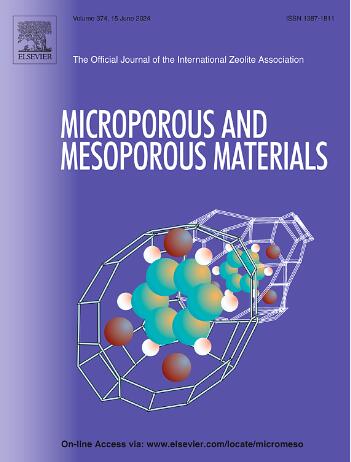The notable features of mesoporous aluminosilicates as catalytic supports for hydrodearomatization and hydrodesulfurization of fuels
IF 4.8
3区 材料科学
Q1 CHEMISTRY, APPLIED
引用次数: 0
Abstract
Despite being discovered more than 25 years ago, mesoporous aluminosilicates are still very relevant materials, considering the huge number of publications appearing every year harnessing them. Their notable features such as high BET surface area, accessible mesopore size, mild acidity and tunable pore wall thickness have resulted in different successful catalytic applications. Additionally, different kinds of mesoporous aluminosilicates may be found in literature (MCM-41, MCM-48, HMS, SBA-15, SBA-16, etc.) that allow to tailor to certain extent some physicochemical properties such as the spatial group, mesopore size and dimension, the pore wall thickness and consequently the hydrothermal stability, for the wanted catalytic application. This review is focused on discussing the main characteristics of the most common mesoporous aluminosilicates and exploring their reported performance in literature as supports of bifunctional catalysts for the hydrodearomatization (HDA) and desulfurization (HDS) of fuels. Although their hydrothermal stability has always been questioned by their lack of crystallinity, several successful applications of both MCM-41 and SBA-15 as supports of bifunctional catalysts for HDA/HDS of model compounds such as dibenzothiophene (DBT) can be found in literature, which in some cases interestingly also point out the prolonged stability of the catalyst, leading towards high yields of fuels by its mild acidity. Additionally, supported metal catalysts over mesoporous aluminosilicates might be the basis for the preparation of advanced bulk metal hydroprocessing catalysts, by application of different etching strategies. Therefore, this review will show these promising catalytic outcomes that opens up the application of mesoporous aluminosilicates as supports of bifunctional catalysts devoted to HDA/HDS of not only model sulfur/aromatic compounds but true fuels as well such as those proceeding from Kazakhstan oil.

求助全文
约1分钟内获得全文
求助全文
来源期刊

Microporous and Mesoporous Materials
化学-材料科学:综合
CiteScore
10.70
自引率
5.80%
发文量
649
审稿时长
26 days
期刊介绍:
Microporous and Mesoporous Materials covers novel and significant aspects of porous solids classified as either microporous (pore size up to 2 nm) or mesoporous (pore size 2 to 50 nm). The porosity should have a specific impact on the material properties or application. Typical examples are zeolites and zeolite-like materials, pillared materials, clathrasils and clathrates, carbon molecular sieves, ordered mesoporous materials, organic/inorganic porous hybrid materials, or porous metal oxides. Both natural and synthetic porous materials are within the scope of the journal.
Topics which are particularly of interest include:
All aspects of natural microporous and mesoporous solids
The synthesis of crystalline or amorphous porous materials
The physico-chemical characterization of microporous and mesoporous solids, especially spectroscopic and microscopic
The modification of microporous and mesoporous solids, for example by ion exchange or solid-state reactions
All topics related to diffusion of mobile species in the pores of microporous and mesoporous materials
Adsorption (and other separation techniques) using microporous or mesoporous adsorbents
Catalysis by microporous and mesoporous materials
Host/guest interactions
Theoretical chemistry and modelling of host/guest interactions
All topics related to the application of microporous and mesoporous materials in industrial catalysis, separation technology, environmental protection, electrochemistry, membranes, sensors, optical devices, etc.
 求助内容:
求助内容: 应助结果提醒方式:
应助结果提醒方式:


